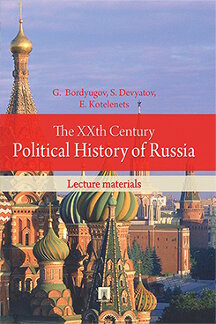|
|
ОглавлениеINTRODUCTION. Theme 1. THE STUDY OF MODERN RUSSIAN HISTORY: MAIN CHARACTERISTICS AND TRENDS Theme 3. FESTIVAL OF THE OPPRESSED OR SOCIAL DISEASE? THE NATURE OF THE RUSSIAN REVOLUTIONS Theme 5. FROM «WAR COMMUNISM» TO THE NEW ECONOMIC POLICY: CONTRADICTIONS OF THE NEP Theme 7. THE 1930S: CRISES, REFORMS, REPRESSIONS Theme 8. THE HIERARCHY OF THE GREAT TERROR Theme 9. ILLUSIONS AND AWAKENING OF THE GENERATION OF 1930S Theme 11. THE PEOPLE AND PROBLEMS OF THE POST-WAR ERA Theme 12. THE KHRUSHCHEV’S THAW AND ITS REVERSE SIDE Theme 13. SIXTIES AND SEVENTIES: FROM REFORMS TO STAGNATION Theme 14. THE 1980S: THE SPACE OF POWER AND A SEARCH FOR NEW WAYS OF HISTORICAL PROGRESS Theme 15. AUGUST PUTSCH OF 1991 AND THE TERMIDOR OF YELTSIN Theme 17. REFORMS AND THE HIERARCHY OF NATIONAL PROJECTS Theme 18. LOCATING OF THE REVOLUTIONARY PERIOD OF 1917 IN RUSSIAN HISTORICAL MEMORY Theme 19. THE GREAT VICTORY OF 1945 IN HISTORICAL MEMORY MAIN EVENTS, DATES AND GLOSSARY Для бесплатного чтения доступна только часть главы! Для чтения полной версии необходимо приобрести книгуMAIN EVENTS, DATES AND GLOSSARYRussia at the Beginning of Twentieth Century (1900–1916) Main Events and Dates
Glossary The Stolypin agrarian reform Envisaged: abolishing the obschina system, consolidating isolated farmsteads and developing large-scale individual farming (khutors), peasants’ resettlement to the south-eastern and eastern regions of the country. The Entente Military alliance of states organized at the beginning of the Twentieth century (1904) and originally consisting of two states: the UK and France. In 1907 Russia joined the alliance, and in 1917 — the United States and Japan. The State Duma Legislative body convoked according to Manifesto issued by Nicholas II on October 17, 1905. It was elected for 5 years. Before the February Revolution there had been four State Dumas. The Constitutional Democratic Party (the Kadets) «Party of National Freedom». Existence from October 1905 until November 1917. Represented the left wing of the Russian liberalism. Were members of all four Provisional Governments. Comprised about 100 thousand people. The October Manifesto (1905) Proclaimed civil liberties, freedom of speech, freedom of assembly, freedom of association. Also mentioned convocation of the Duma. Soviets of workers’ deputies Form of power of the working class, which appeared in the course of the First Russian Revolution, in summer 1905 in Ivanovo-Voznesensk. During the October political strike the Soviets appeared in different cities and towns. «The Union of October 17» Bourgeoisie party, comprised about 60 to 70 thousand members. Its ideal — strong monarchical power. Supported united and indivisible Russia and expansion of labor legislation. «The Union of the Russian people» Monarchist party (about 4100 thousand people) defended autocracy, police power and manor’s land ownership. The June 3 Coup (the 3 June Monarchy) Dissolution of the Second State Duma. The June 3 Monarchy called for the preservation of absolute monarchy, which more often resorted to strong-arm tactics in politics and had two-chamber parliament. It relied on upper bourgeoisie encouraging capitalist production but didn’t allow bourgeoisie come to power. The Labor group Faction of deputies-peasants and popular intelligentsia in I–IV sessions of the Duma (107 people in the First Duma). Played an important role in the political life of the country. The Labor group program was welcomed by millions of peasants. 1917 Main Events and Dates
Glossary Brest treaty Peace treaty between Soviet Russia on the one side and the coalition of Germany, Austria-Hungary and Turkey on the other. Provisional Government Supreme legislative and executive authority in Russia from March 2 to October 25, 1917 All-Russian Central Executive Committee of Soviets of Workers’, Soldiers’ and Peasants’ Deputies Authority that exercised general control over Soviets in-between congresses of the Soviets. VChK / All-Russian Extraordinary Commission Established in December, 1917 for combating counter-revolution and sabotage. Diarchy Specific political situation that existed in Russia after the February revolution from March 2 to July 4, 1917. The first power (bourgeois dictatorship) was represented by the Provisional government that sought for parliamentary monarchy. The second, by the Soviets of workers’ and soldiers’ deputies that aspired creation of the republic. The absolute rule of the provisional government was established after the shooting of demonstrators in Petrograd on June 4, 1917. Decree One of the denominations of the document issued by the supreme public authority. In the first soviet years, laws and resolutions of SNK (Council of People’s Commissars), the Congress of Soviets and its executive bodies were called decrees. Thus, the Decree on Peace and the Decree on Land were passed by the Second Congress of Soviets on the night of October 27, 1917. Commune A form of agricultural cooperative with socialization of means of production and equalizing distribution per head. Communes first appeared at the end of 1917 on the lands of former landowners. People’s Commissariats (the Narkomats) Central public authorities in different sectors, created after the October revolution. They were established by the decree of the Second All-Russian Congress of Soviets on October 26, 1917. Nationalization Transition of private businesses, land, transport, telecommunications, banks to state ownership by measures of compulsion as well as on basis of full or partial redemption. Prodotryads (Food detachments) Part of food-confiscation forces in the course of food dictatorship; consisted of armed worker, poorer peasants usually aligned with the interior guard forces and committees of the poor. Внимание! Авторские права на книгу "The XXth Century Political History of Russia: lecture materials" (Bordyugov G., Devyatov S., Kotelenet E.) охраняются законодательством! |
||||||||||||||||||||||||||||||||||||||||||||||










